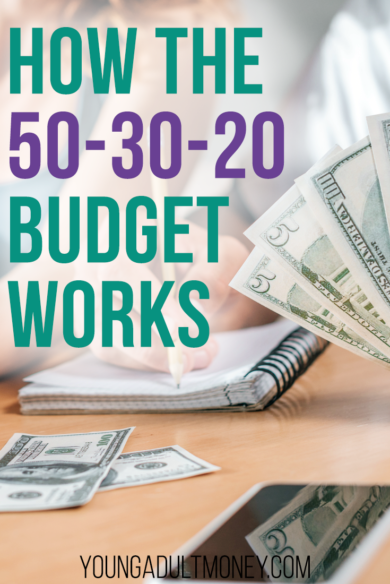 Looking for a new way to budget? You may want to consider trying the 50-30-20 Budget.
Looking for a new way to budget? You may want to consider trying the 50-30-20 Budget.
What is the 50-30-20 Budget? It’s a budget popularized by Senator Elizabeth Warren, who wrote about it in her book All Your Worth – the Ultimate Lifetime Money Plan.
The basics of the 50-30-20 Budget breaks down your take-home pay into three main buckets:
- 50% Needs
- 30% Wants
- 20% Savings / Investing / Debt Repayment
Your take-home pay is the amount of income you bring home after taxes. Many people have money taken out of their paycheck for health insurance premiums, retirement account contributions, and other adjustments prior to the actual “paycheck amount’ that hits your checking account. When working through the 50-30-20 budget, add back in anything that is taken out after taxes, but prior to the actual amount hitting your checking account. That’s your true “take-home pay” that will be divided among the 50-30-20 buckets.
50% Needs
50% of your income should be spent on needs, which are areas of spending you actually need in order to survive. This includes necessary spending each month, for things like housing, food, healthcare, utilities, minimum debt payments, and more.
30% Wants
On the 50-30-20 budget, you should aim to spend just 30% of your income on things you want. This includes entertainment expenses, eating out, shopping, vacations, and more.
Many people struggle to determine the true difference between needs and wants. Things you want may help to improve your quality of life, but you don’t necessarily need them in order to survive. Everyone has different priorities, but unless it is required for basic survival, potential purchases most often fall into the “want” category. Keep in mind, if you find that your “want” portion of your budget is way over, then you may need to make some serious sacrifices in order to meet your financial goals.
20% Savings / Investing / Debt Repayment
Last but not least, the remaining 20% is the amount you put towards meeting your financial goals. This includes things like retirement savings, emergency fund savings, and debt repayment above and beyond the minimum required monthly payment.
How to Use the 50-30-20 Budget
The 50-30-20 Budget is not a perfect model. You don’t have to adhere to it perfectly – but it is an excellent guideline for anyone looking for a simple starting point with their budget.
After following this budget, it is likely that your spending won’t match the given percentages exactly. And that’s okay. However, if you find that you’re spending a much higher percentage on wants instead of savings/debt/investing, you can then realize you may want to shift your priorities around. If your “needs” are too high, you may want to look at finding more affordable rent, or moving someplace with a lower cost of living.
Keep in mind, the 50-30-20 budget can vary depending on a variety of factors. If you have a fairly high or a fairly low salary, it is likely that these percentages will look different for you. For instance, if you have a smaller salary, you are likely spending more on your basic living expenses, and less on wants. And if your salary is high in comparison to where you live, you may (hopefully) be spending more in your savings and investing goals, but have a lower “needs” category.
A few other tips to keep in mind when preparing your 50-30-20 Budget:
Distinguish between “Needs” and “Wants.” While having food, clothing, and shelter are considered to be the basic needs, it’s easy for the line between “needs” and “wants” to become blurred. For instance, you may need a vehicle to get to and from work. But the price between a modest used car and a Porsche is drastic – you don’t “need” a fancy car. Nor do you “need” the downtown high-rise apartment, or the designer clothing. Everyone’s needs should be fairly basic. If you find your “needs” list is more expensive than 50% of your income, then take a look to decide if anything is actually more of a “want.”
Consider increasing the 20%. If you can provide for your basic needs, and limit your “wants” category, then you can throw even more money towards your savings for debt-repayment goals. By doing this, you will significantly improve your life and your future.
Earn more money. If you want to further yourself in any of these categories, remember you can always work to earn more money. Whether you choose to start a side hustle or work to earn more at your 9-5 job, any extra money you make can go straight to the area where you want to be able to contribute more money.
Come to terms with your priorities. Hey, we all have certain areas of spending that we’d hate to give up if we don’t have to. Whether you are passionate about clothes shopping, eating out, golf, or something else, if these “wants” are important to you, then budget them in. There’s no shame in spending money in something you truly want to do – the key is to stop spending money on things that are nice to have, but you don’t necessarily want or need.
Related:
Have you tried the 50-30-20 Budget? If so, what are your thoughts? If you haven’t, what other budgeting strategies have you tried?


really a good method when you are paying off debt and try to save at the same time!!!
I’ve actually been hearing this budget more and more lately. I like it because it’s simple. And honestly, most of the investing, saving, debt repayment, and regular expenses can be automated. I think we only actually manage about 15% of our money and the rest is automatically achieving our financial goals for us.
Those are great points! Keeping a simple budget is really key to success.